Are you preparing to welcome a Tibetan Mastiff puppy into your home? You may be wondering how big your Tibetan Mastiff may get. Below, we discuss everything you need about Tibetan Mastiff growth progression, including a month-to-month growth chart, milestones, and training tips!
Tibetan Mastiff Progression: Breed Summary

The lovable Tibetan Masttif is known for its lion-like fluffy mane and soft, luxurious fur.
©Olga Aniven/Shutterstock.com
The Tibetan Mastiff is an ancient breed originating from the Himalayan region. Thanks to their intimidating size and loyal nature, Tibetan Mastiffs acted as guard dogs to Buddhist monks thousands of years ago and guarded livestock. It has been said that Genghis Khan kept Tibetan Mastiffs in his army. Today, Tibetan Mastiffs are beloved for their loving and affectionate nature towards their families. These large, powerful dogs have fluffy, thick coats of fur and a distinct lion-like mane around their necks.
Tibetan Mastiff Progression: Growth and Weight Chart by Age
The following growth chart shows the average weight range for Tibetan Mastiffs as they grow. Although the weight of individual dogs can vary, the next gives you a general idea of what to expect from your puppy.
| Age | Female Tibetan Mastiff Weight | Male Tibetan Mastiff Weight |
|---|---|---|
| Birth | 13-22 ounces | 13-22 ounces |
| 1 Month | 5-10 pounds | 5-10 pounds |
| 2 Months | 15-30 pounds | 10-25 pounds |
| 3 Months | 30-45 pounds | 25-40 pounds |
| 4 Months | 45-60 pounds | 30-45 pounds |
| 5 Months | 50-75 pounds | 35-60 pounds |
| 6 Months | 55-85 pounds | 40-60 pounds |
| 7 Months | 60-90 pounds | 45-65 pounds |
| 8 Months | 60-95 pounds | 50-70 pounds |
| 9 Months | 70-105 pounds | 55-80 pounds |
| 10 Months | 70-115 pounds | 55-90 pounds |
| 11 Months | 75-125 pounds | 60-100 pounds |
| 12 Months | 80-135 pounds | 60-110 pounds |
| 2 Years | 90-150 pounds | 70-120 pounds |
Tibetan Mastiff Progression: When Will My Tibetan Mastiff Stop Growing?
Tibetan Mastiffs typically reach their adult size by 18 months. However, some will continue to develop muscle until two years of age. How much food to give them per day depends on the type of food and your dog’s size and activity levels. Veterinarians recommend feeding your Tibetan Mastiff puppy a high-quality, large-breed diet rather than regular puppy food. This is because large breed dogs have different nutritional needs than smaller ones.
Regular checkups with your vet can help ensure your puppy grows healthy and eats the correct type (and right amount) of food. While adult dogs should see their vet at least once a year, puppies need checkups more often. Your Tibetan Mastiff puppy should go to the vet at least every three to four weeks until they are 16 weeks of age.
How Big Will My Tibetan Mastiff Be When It’s Fully Grown?
Male dogs of this breed tend to be larger than the females. Male Tibetan Mastiffs typically range in size from 90 to 150 pounds and can grow at least 26 inches tall. However, this can vary based on a dog’s genetics and diet.
The Biggest Tibetan Mastiff Ever Recorded
Although most Tibetan Mastiffs will not reach over 150 pounds, a giant Tibetan Mastiff has gone viral on TikTok as his owner attempts to help the furry beast climb into a car. The owner says his dog, which looks more like a fluffy bear than a mastiff, weighs over 300 pounds. That’s twice the size of a typical adult Tibetan Mastiff male.
When Should My Tibetan Mastiff Be Spayed or Neutered?
Veterinarians recommend waiting for large-breed dogs to reach puberty at around 11 or 12 months before neutering or spaying. Research suggests large dogs can develop orthopedic problems later in life if spayed or neutered before sexual maturity. Spaying or neutering too soon has also been found to delay the closure of growth plates in big bones.
According to the American Veterinary Medical Association, spaying and neutering dogs offers several health benefits. Neutering male dogs can remove all risks of testicular cancer and reduce the risk of enlarged prostate glands. Spaying female dogs can reduce the risk of breast cancer and prevent uterine infection.
When Should My Tibetan Mastiff Be House Broken?
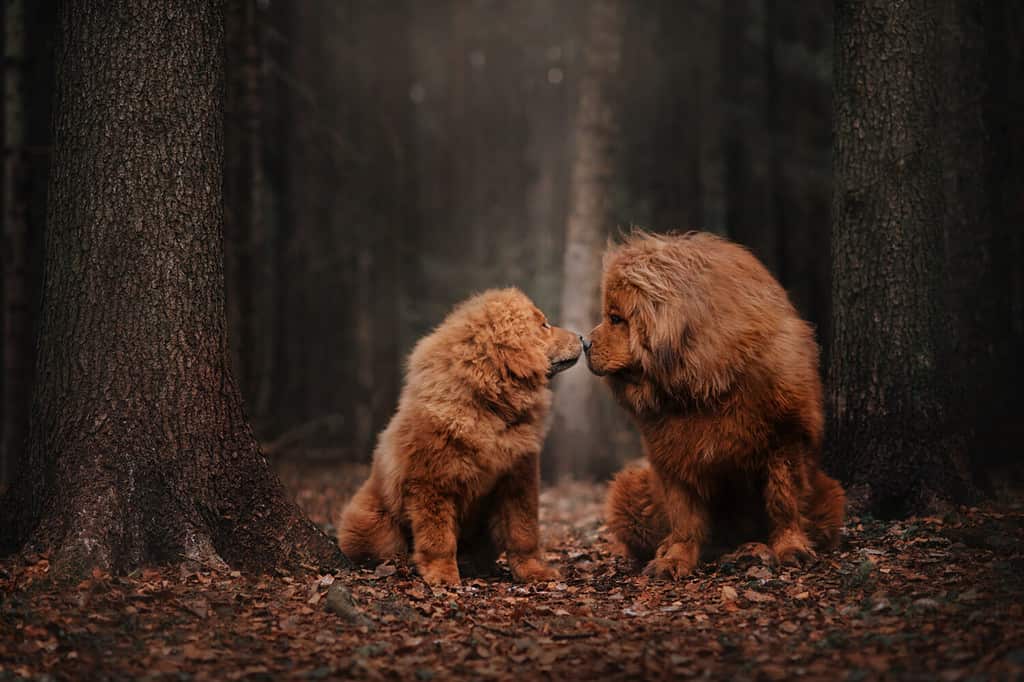
You can start teaching your pup simple commands when you bring them home.
©Ksenia Raykova/Shutterstock.com
Housebreaking a Tibetan Mastiff puppy is not very different from training any other puppy. When you bring your new puppy home, take her out at regular intervals and always after meals, playing, and sleeping. Although it could take months to fully potty train your pup, once your dog is 8 to 12 weeks of age, he can begin learning to go to the bathroom outside. Be sure to offer treats and praise when your puppy does what you want her to do. Watch your puppy for cues; remember, patience and consistency are the keys to housetraining any dog.
When Should My Tibetan Mastiff Stop Eating Puppy Food?
According to the American Kennel Association, large-breed dogs should continue eating puppy food until they are 12 to 14 months old. Puppies need a different diet from adults because their numbers are increasing, and they have complex nutritional needs. Switching to adult food too early will mean your puppy isn’t getting the nutrients it needs.
Furthermore, Tibetan Mastiffs have different nutritional needs than smaller dogs. Feeding your dog a diet formulated especially for large dogs is essential. Large-breed puppy food has fewer calories than that for smaller dog breeds. Though this may sound counterintuitive, it prevents a large dog breed from growing too quickly, which can lead to bone and joint problems. Large-breed dogs also need nutrients such as glucosamine and chondroitin to help support their joint health. You can ask your vet for recommended dog foods. Or check out this list by A-Z Animals for a list of high-quality diets for larger dogs. Taste of the Wild Pacific Stream Grain-Free Dry Dog Food was rated best overall.
Tibetan Mastiff Progression: When Will My Tibetan Mastiff Start Losing Teeth?
Most puppies begin losing their baby teeth and growing their adult teeth around 12 to 16 weeks. Your dog’s puppy teeth should have fallen out by six months, and the adult ones should have grown in. Like in human babies, teething can cause your pup discomfort as the baby teeth fall out and the adult teeth erupt. You can help your dog by offering safe chew toys for him to chew on.
Cold and frozen items can help relieve your dog’s painful gums. Any dog-safe toy can be put in the freezer and given to your dog. You can also freeze fruit and vegetables for your pup, being careful it’s the right size for your dog. However, stay away from offering ice cubes. Something as complex as ice can cause puppy teeth to break.
When Should I Start Training My Tibetan Mastiff?
You can start training your Tibetan Mastiff when you bring your new puppy home. Because they are such large and intelligent dogs, socializing and training your mastiff is essential to having a happy and well-balanced dog. Therefore, the earlier you begin training, the easier it will be to establish good habits and prevent behavior issues later. Tibetan Mastiffs are known to be independent and somewhat headstrong.
Tibetan Mastiffs are working dogs that were initially bred as guard dogs. Though they can be taught, dog trainers recommend using fun training techniques. This sensitive breed may not respond well to traditional training. Because they are so intelligent, they will catch on quickly and don’t appreciate repetition. Dog experts agree gaining your Tibetan Mastiff’s trust and respect is vital to having a positive relationship.
Puppies go through an adolescent phase, around eight months to two years, when they may become more stubborn and desire to begin exploring the world outside of their former comfort zone. Training your pup early will help you get through this trying phase.
What Cues Should I Teach My Tibetan Mastiff First?
Dog trainers recommend positive reinforcement as the best way to train any dog, regardless of breed. Teaching your dog to come when called can prevent your pet from getting lost or running away in a dangerous situation. And “leave it” is another crucial command. From your favorite slippers to a dead rodent found in the backyard, sometimes you will need your dog to drop whatever she has put in her mouth. You can begin by teaching your dog a list of simple commands, including “come,” “sit,” “stay,” and “leave it.” Make training fun and offer rewards of treats and praise.
When Will My Tibetan Mastiff Calm Down?
Puppies are known to have an abundance of energy. You can help your dog by offering regular exercise and training. An exercised dog is much less likely to engage in destructive behaviors than a bored dog. Keep your training consistent and provide opportunities for your dog to get socialized. A good obedience class will do more than train your dog. It will teach you how to prepare it. If you are unsure where to go, veterinarians usually keep lists of local dog trainers they recommend.
Like all dogs, Tibetan Mastiff puppies lose some of their puppy exuberance when fully grown. For many dogs, this is around one year of age. However, for larger dog breeds, including Tibetan Mastiffs, it may not happen until they are about two years old.
Common Health Issues Your Tibetan Mastiff Might Experience
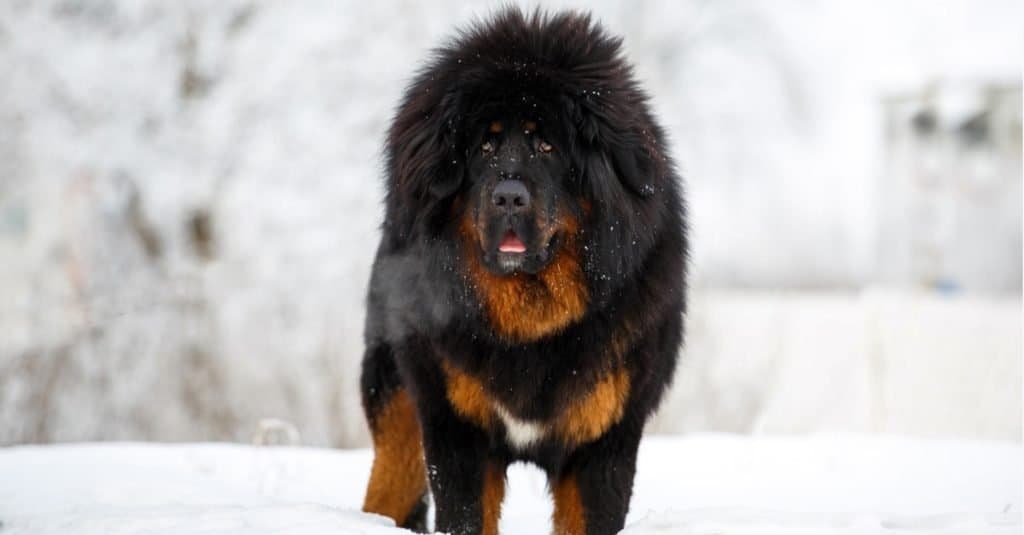
You can help your Tibetan Mastiff to keep a healthy weight by ensuring he gets exercise.
©Tatyana Kuznetsova/Shutterstock.com
Tibetan Mastiffs are generally a hardy breed, but they can suffer from health issues such as:
- Hip and elbow dysplasia (the ball and socket joint becomes loose or unstable)
- Hypothyroidism (underactive thyroid)
- Eye problems (Progressive Retinal Atrophy)
- Luxating patella (where the kneecap moves out of position)
- Skin allergies
You can help to prevent hip and elbow dysplasia and luxating patella by keeping your Tibetan Mastiff at a healthy weight. Tibetan Mastiffs are especially prone to obesity, which can cause many health problems, including heart disease and diabetes. Ensure your dog eats a high-protein, low-fat diet and gets plenty of exercise. Regular vet checkups can ensure your dog is maintaining a healthy weight.
Pictures of Tibetan Mastiffs as Puppies
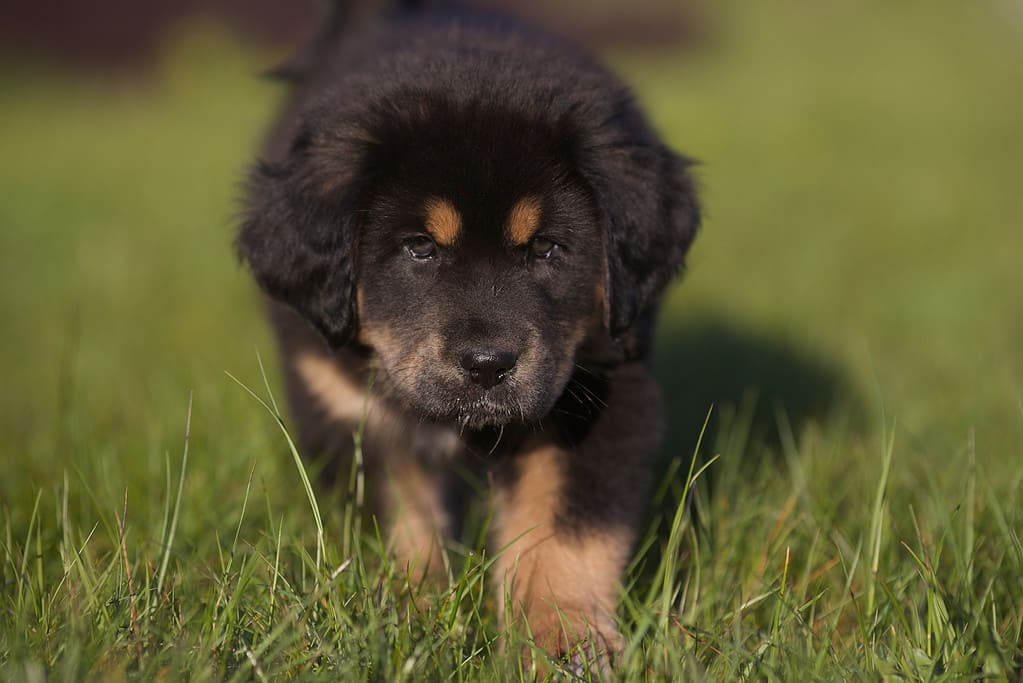
Tibetan Mastiff puppies can range from 10 to 30 pounds at two months.
©agrisk/iStock via Getty Images
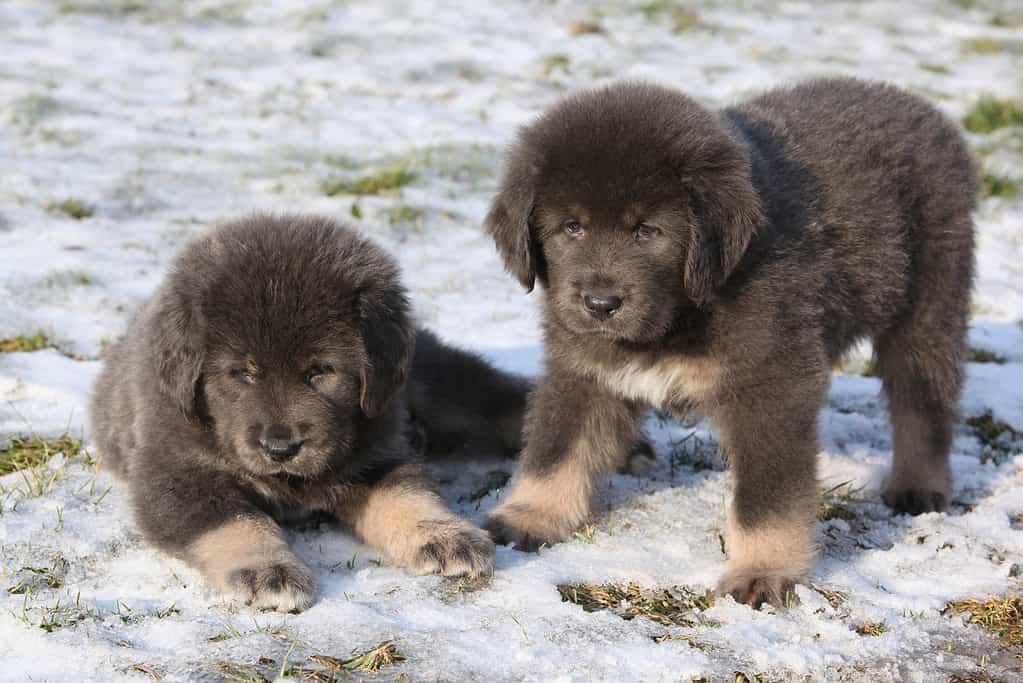
With their thick fur, even Tibetan Mastiff puppies enjoy the snow.
©Zuzule/iStock via Getty Images
Pictures of Tibetan Mastiff at 6 Months

A Tibetan Mastiff should still eat puppy food at six months of age.
©helen2552/iStock via Getty Images
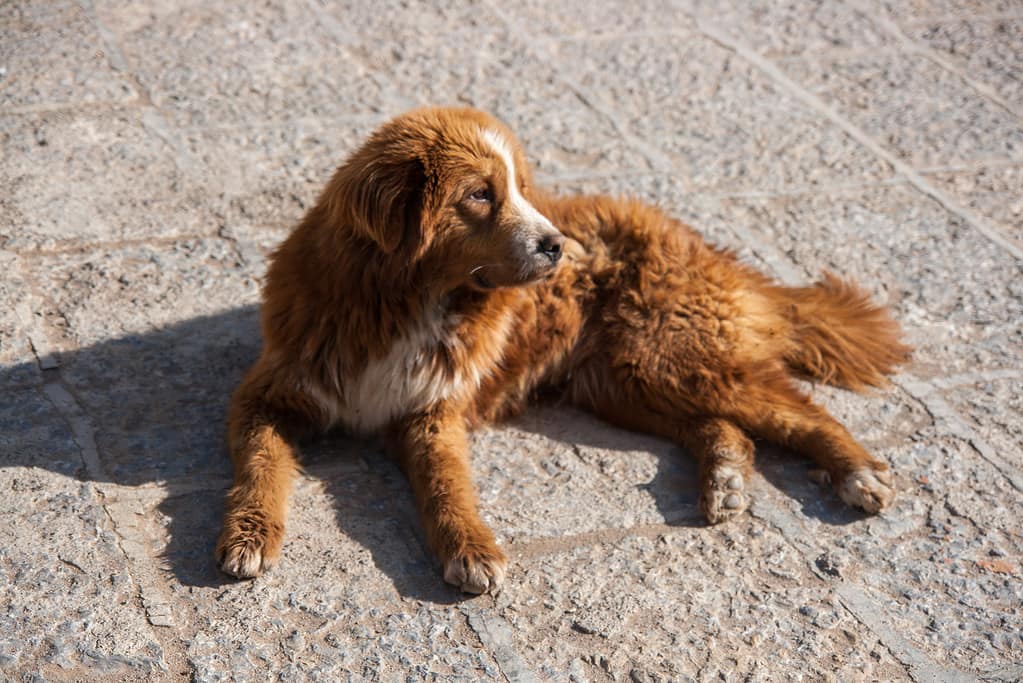
Young Tibetan Mastiffs don’t grow their characteristic fluffy mane until they age.
©Maodoltee/iStock via Getty Images
Pictures of Fully Grown Tibetan Mastiff
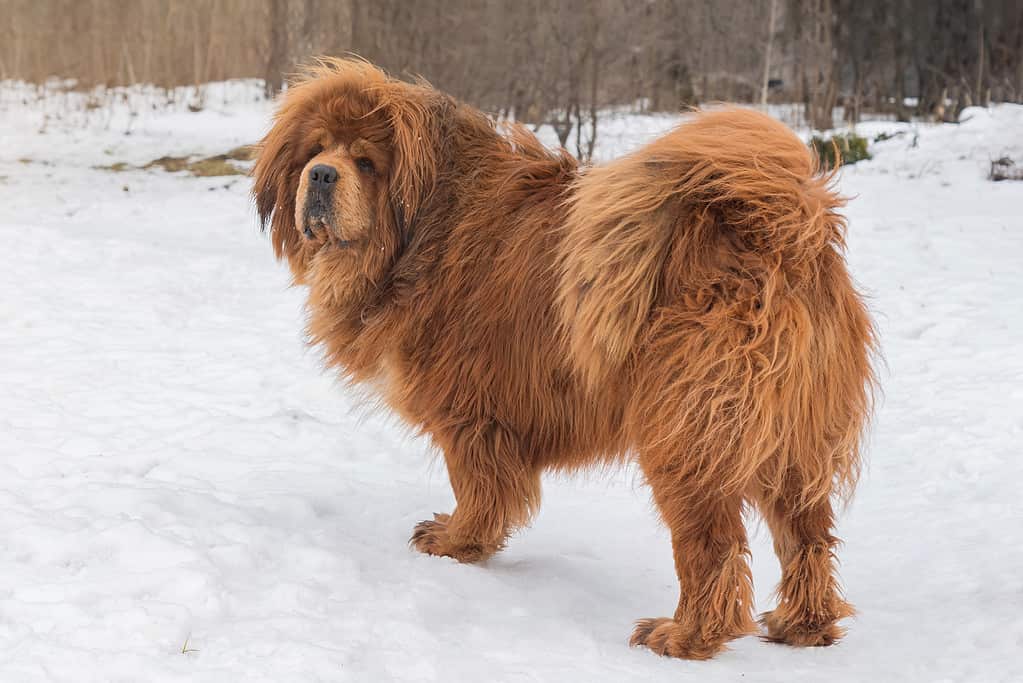
The regal Tibetan Mastiff can get up to 150 pounds, or in some cases, even more, when fully grown.
©Oleksandr Hryvul/iStock via Getty Images

Tibetan Mastiffs come in various colors, including black and tan, red, black, and bluish-gray shades.
©Tetiana Kolubai/iStock via Getty Images
Other Dog Breeds Similar to Tibetan Mastiffs
The photo featured at the top of this post is © Kat_marinina/Shutterstock.com
Ready to discover the top 10 cutest dog breeds in the entire world?
How about the fastest dogs, the largest dogs and those that are -- quite frankly -- just the kindest dogs on the planet? Each day, AZ Animals sends out lists just like this to our thousands of email subscribers. And the best part? It's FREE. Join today by entering your email below.
Thank you for reading! Have some feedback for us? Contact the AZ Animals editorial team.






